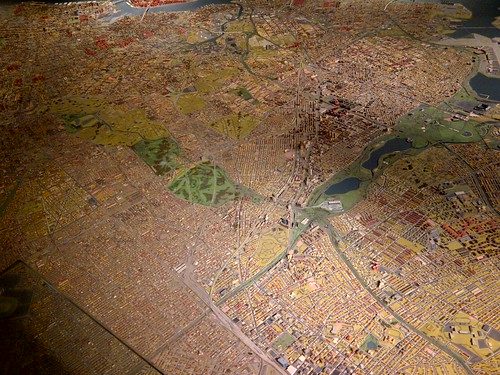This was the second event of the day at Casa Neta for the New Yorker Festival. Anyone with tickets for the second event had to go outside and stand on a special line. We would be getting back into the restaurant before the others who had not attended the first event. Since I was very near the front of the line, I got a table and was able to try the chips with salsa and guacamole. I did make a bit of pig of myself. Not sure why. Maybe it was the two strong drinks I’d had at the Flavors of Mexico event. I considered having another drink but decided to stick with water. The waiters were passing around the same food as before with a chipotle fish taco being the only new food.
This event was the history of mezcal and a demonstration of the making of a Flor de Muerto
Ivan Martinez-Vega from the Mexican Tourism Board and Alejandra González Anaya, who is running the Mexico City Day of the Dead parade, gave generally the same speeches they had given for the first event.
Steve Olson, who helped open Gramercy Tavern and is a beverage and service consultant, handled the mezcal tasting of a mezcal he brought to the US 21 years ago. Distillation has been taking place in Mexico since 600 BCE. He said the Aztecs created the calendar, telescope, and corn. Wikipedia tells me it’s the Mayans that domesticated corn and that the Aztecs studied the sky but nothing about a telescope. So now I’m not sure what he said is true or what is hyperbole.
Mezcal is called medicina in Oaxaca and the agave is called maguey. In Mexico the native people used all parts of the agave plant, including using the fibers for sails. Mezcal is used for ritual purposes (including celebrations) and is drunk from gourds. The gourds cannot be imported to the US so we were served our taste of Del Maguey mezcal in cupitos. Olson taught us a word that they say before drinking which means “to your health” and a bunch of other stuff. Also before you drink the patriarch pours a little mezcal onto the ground in a cross pattern – to the earth and the sky.
Olson told us that mezcal has nothing to do with mescaline, which apparently some people do believe (I didn’t know that was a common belief). Also the worm in the bottle is a marketing gimmick. No one drinks the worm in Mexico. Tequila used to be under the heading of mezcal but now mezcal production is limited to only five states in Mexico. Tequila is now considered a separate product.
This mezcal is made in Chichicapa, Oaxaca and is made by one family. The leaves are brought down the mountain by a burro and the hearts of the agave are cooked for three days and then ground. I forgot the rest of the distillation process but I did enjoy my few sips of Del Maguey. It was very smooth.
When Olson first met with the family and asked questions about how something was done the answer was from father to son, from father to son, from father to son. It was the same response to every question. Finally, they enjoyed some mezcal together and when the father saw that Olson could keep up with him, he became friendlier and shared more information and Olson became the US distributor.
Bartender Hector Aponte mixed a Flor de Muerto but didn’t tell us the proportions, so I know the ingredients but I don’t know how much of each.
I grabbed a few more of the small bites being passed around and then started uptown to see the fifth and last program of the 2016 Fall for Dance Festival.
By Carene Lydia Lopez













